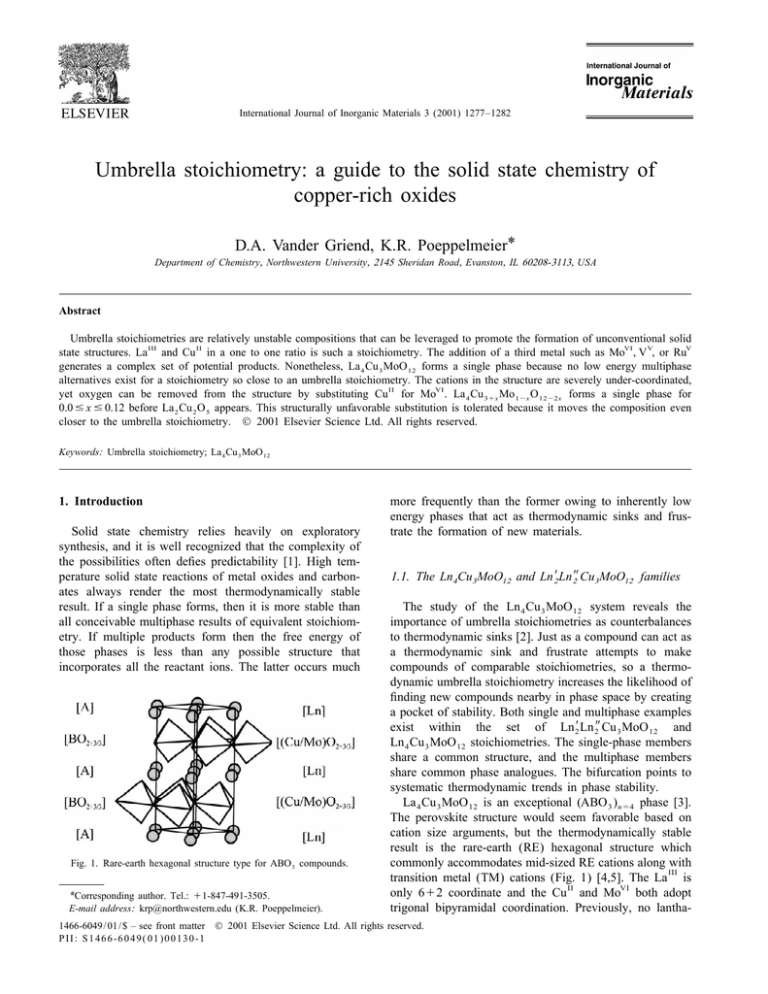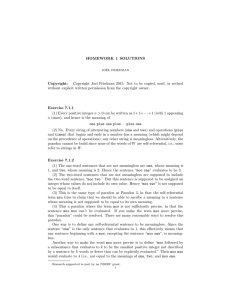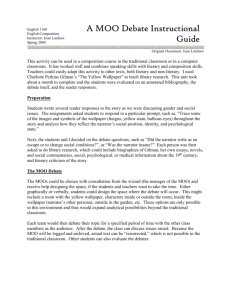
International Journal of Inorganic Materials 3 (2001) 1277–1282
Umbrella stoichiometry: a guide to the solid state chemistry of
copper-rich oxides
D.A. Vander Griend, K.R. Poeppelmeier*
Department of Chemistry, Northwestern University, 2145 Sheridan Road, Evanston, IL 60208 -3113, USA
Abstract
Umbrella stoichiometries are relatively unstable compositions that can be leveraged to promote the formation of unconventional solid
state structures. La III and Cu II in a one to one ratio is such a stoichiometry. The addition of a third metal such as MoVI , V V, or RuV
generates a complex set of potential products. Nonetheless, La 4 Cu 3 MoO 12 forms a single phase because no low energy multiphase
alternatives exist for a stoichiometry so close to an umbrella stoichiometry. The cations in the structure are severely under-coordinated,
yet oxygen can be removed from the structure by substituting Cu II for MoVI . La 4 Cu 31x Mo 12x O 1222x forms a single phase for
0.0 # x # 0.12 before La 2 Cu 2 O 5 appears. This structurally unfavorable substitution is tolerated because it moves the composition even
closer to the umbrella stoichiometry. 2001 Elsevier Science Ltd. All rights reserved.
Keywords: Umbrella stoichiometry; La 4 Cu 3 MoO 12
1. Introduction
Solid state chemistry relies heavily on exploratory
synthesis, and it is well recognized that the complexity of
the possibilities often defies predictability [1]. High temperature solid state reactions of metal oxides and carbonates always render the most thermodynamically stable
result. If a single phase forms, then it is more stable than
all conceivable multiphase results of equivalent stoichiometry. If multiple products form then the free energy of
those phases is less than any possible structure that
incorporates all the reactant ions. The latter occurs much
Fig. 1. Rare-earth hexagonal structure type for ABO 3 compounds.
*Corresponding author. Tel.: 11-847-491-3505.
E-mail address: krp@northwestern.edu (K.R. Poeppelmeier).
more frequently than the former owing to inherently low
energy phases that act as thermodynamic sinks and frustrate the formation of new materials.
1.1. The Ln4 Cu3 MoO12 and Ln 92 Ln 99
2 Cu3 MoO12 families
The study of the Ln 4 Cu 3 MoO 12 system reveals the
importance of umbrella stoichiometries as counterbalances
to thermodynamic sinks [2]. Just as a compound can act as
a thermodynamic sink and frustrate attempts to make
compounds of comparable stoichiometries, so a thermodynamic umbrella stoichiometry increases the likelihood of
finding new compounds nearby in phase space by creating
a pocket of stability. Both single and multiphase examples
exist within the set of Ln 92 Ln 299 Cu 3 MoO 12 and
Ln 4 Cu 3 MoO 12 stoichiometries. The single-phase members
share a common structure, and the multiphase members
share common phase analogues. The bifurcation points to
systematic thermodynamic trends in phase stability.
La 4 Cu 3 MoO 12 is an exceptional (ABO 3 ) n 54 phase [3].
The perovskite structure would seem favorable based on
cation size arguments, but the thermodynamically stable
result is the rare-earth (RE) hexagonal structure which
commonly accommodates mid-sized RE cations along with
transition metal (TM) cations (Fig. 1) [4,5]. The La III is
only 612 coordinate and the Cu II and MoVI both adopt
trigonal bipyramidal coordination. Previously, no lantha-
1466-6049 / 01 / $ – see front matter 2001 Elsevier Science Ltd. All rights reserved.
PII: S1466-6049( 01 )00130-1
1278
D. A. Vander Griend, K.R. Poeppelmeier / International Journal of Inorganic Materials 3 (2001) 1277 – 1282
nide cation larger than europium has been incorporated.
Truly, the discovery of the lanthanum compound is
anomalous, but that of the smaller lanthanide analogues
can be anticipated. Substitution is often possible because
of the similarity between the trivalent lanthanides, and the
predicted isomorphic structures of Ln 4 Cu 3 MoO 12 for
smaller Ln approach the expected hexagonal structure type
based on ABO 3 radius ratio comparisons [4].
Ln 4 Cu 3 MoO 12 formed a single phase for all of the
common trivalent lanthanides larger than ytterbium (Ln5
La, Pr, Nd, Sm–Tm) and Fig. 2 shows which combinations
of Ln 92 Ln 299 Cu 3 MoO 12 formed a single phase [2]. The
lattice parameters change linearly with average A-cation
size and those of the Ln 92 Ln 299 Cu 3 MoO 12 members correspond closely to the average of the two end members,
Ln 4 Cu 3 MoO 12 and Ln 99
4 Cu 3 MoO 12 . This particular B-cation composition (75% copper and 25% molybdenum)
increases the tolerable average A-cation size of the RE
hexagonal structure type, but could not stabilize the
smallest lanthanide analogues, Yb and Lu, which typically
form a different structure for ABO 3 stoichiometries. No
single phases with a 50 / 50% mixture of lanthanide Acations form with Yb or Lu either. The nine white squares
lie at the boundary between single and multiple phase
samples and indicate samples that contained a mixture of
phases one of which resembled the target phase in structure.
Attempts to make La 2 Ho 2 Cu 3 MoO 12 did not result in a
single phase. Surprisingly, they also did not result in the
segregation of the two parent phases, La 4 Cu 3 MoO 12 and
Ho 4 Cu 3 MoO 12 , both of which form under identical conditions. Furthermore, no phase with the targeted rare-earth
hexagonal structure formed. The result was an ordinary set
of simple oxides: La 2 MoO 6 , CuO and Ho 2 Cu 2 O 5 . The
same result proved true for the other combinations of Ln9
and Ln0 where the size mismatch between the lanthanides
was too large (Dr.14 pm). Fig. 2 codes all the experimental results for the Ln 92 Ln 299 Cu 3 MoO 12 family. Additional
results (marked with an *) are anticipated based on the two
requirements for the formation of the single phase: (1)
Fig. 2. Chart of Ln 4 Cu 3 MoO 12 and Ln 29 Ln 992 Cu 3 MoO 12 synthesis attempts. Light gray squares indicate single-phase products. Dark gray squares indicate
multiphase products comprised solely of metal and binary metal oxides. White squares indicate multiphase products where one of the phases has the
targeted rare-earth hexagonal structure. Squares marked with an asterisk are anticipated results in accordance with experimental results (r¯ $105 pm and
Dr#14 pm).
D. A. Vander Griend, K.R. Poeppelmeier / International Journal of Inorganic Materials 3 (2001) 1277 – 1282
sufficiently large average lanthanide size (r¯ $105 pm5
r( IX Tm III )), and (2) sufficiently small difference between
the lanthanide cation sizes (Dr#14 pm).
1.2. Substantiation of umbrella stoichiometry concept
The fact that an ordinary set of products forms when
targeting La 2 Ho 2 Cu 3 MoO 12 illustrates the peculiarity of
single-phase compositions like La 4 Cu 3 MoO 12 and
Ho 4 Cu 3 MoO 12 . The explanation for this extraordinary
result leads to the chemical principle of umbrella stoichiometries.
The specific oxide compositions that form as the
thermodynamic products define a stability hierarchy. Since
La 4 Cu 3 MoO 12 and Ho 4 Cu 3 MoO 12 form single phases,
they are more stable than any set of multiphase alternatives.
DG(La 4 Cu 3 MoO 12 ) , DG(La 2 Cu 2 O 5 1 La 2 MoO 6
1 CuO)
(1)
DG(Ho 4 Cu 3 MoO 12 ) , DG(Ho 2 Cu 2 O 5 1 Ho 2 MoO 6
1 CuO)
(2)
Averaging Eqs. (1) and (2) yields an overall comparison.
1
]
2
DG(La 2 Cu 2 O 5 1 La 2 MoO 6 1 Ho 2 Cu 2 O 5 1 Ho 2 MoO 6
1 2CuO) . ]12 DG(La 4 Cu 3 MoO 12 1 Ho 4 Cu 3 MoO 12 )
(3)
Experiment reveals that
DG(La 2 MoO 6 1 Ho 2 Cu 2 O 5 1 CuO)
, DG( ]21 La 4 Cu 3 MoO 12 1 ]21 Ho 4 Cu 3 MoO 12 )
(4)
The right sides of Eqs. (3) and (4) are equal, and so the
transitive property of inequality demands that
DG(La 2 MoO 6 1 Ho 2 Cu 2 O 5 1 CuO) , ]21 DG(La 2 Cu 2 O 5
1 La 2 MoO 6 1 Ho 2 Cu 2 O 5 1 Ho 2 MoO 6 1 2CuO)
(5)
or after subtracting common terms and multiplying by two
to eliminate fractions,
DG(La 2 MoO 6 1 Ho 2 Cu 2 O 5 ) , DG(La 2 Cu 2 O 5
1 Ho 2 MoO 6 )
(6)
Eq. (6) can be generalized for any pair of lanthanide
cations in the copper molybdate system that differ in size
by more than 14 pm. Ln 2 Cu 2 O 5 is more stable for smaller
lanthanides (green phase), and likewise Ln 2 MoO 6 is more
stable for larger lanthanides. If this were not true, then the
segregation of the two parent phases, Ln 94 Cu 3 MoO 12 and
Ln 94 Cu 3 MoO 12 , would be the most stable multiphase
result. Conversely, Ln 2 Cu 2 O 5 is relatively unstable for
larger lanthanides and Ln 2 MoO 6 for smaller lanthanides.
Ln 4 Cu 3 MoO 12 must represent a stoichiometry that is
couched between the stability of Ln 2 Cu 2 O 5 and
1279
Ln 2 MoO 6 1CuO.
All
three
stoichiometries
(Ln 4 Cu 3 MoO 12 , Ln 2 Cu 2 O 5 , and Ln 2 MoO 6 1CuO) represent Ln(Cu / Mo)O 3 stoichiometries that differ only in the
ratio of Cu II to MoVI .
Fig. 3 depicts the qualitative stabilities for such stoichiometries for all the lanthanides. The stability of Ln 2 Cu 2 O 5
(100% of the TM cations are copper) is less than that for
Ln 4 Cu 3 MoO 12 (75%) on the right side of the diagram and
greater than it on the left side. The opposite is true for the
stability of Ln 2 MoO 6 1CuO (50%). The specific 3 to 1
ratio of copper to molybdenum permits the formation of
the single phase by rendering all alternative sets of
products less stable than the single phase. Despite a
possible oxide that is more stable than the single phase, the
hypothetical leftover is too unstable. The multiphase line,
which is the average of the Ln 2 Cu 2 O 5 stability line and the
Ln 2 MoO 6 1CuO stability line, lies above the single-phase
line except for Ln5Yb and Lu. For Ln5La–Tm, a single
phase forms as the thermodynamic product; and for the
larger lanthanides, this phase forms despite inappropriate
cation sizes because the stoichiometry renders all other
possibilities even less stable.
The drawing of Fig. 3 is qualitative in nature and
intended to help explain the stability of the Ln 4 Cu 3 MoO 12
and Ln 92 Ln 299 Cu 3 MoO 12 phases. The small lanthanides
prefer to pair up with the copper, while the large ones
prefer the molybdenum. We observe that there exists an
intermediate ratio between 100% copper and 50% copper
that allows for the formation of a new single phase if the
two lanthanides are close enough in size. If either
Ln 2 Cu 2 O 5 or Ln 2 MoO 6 were to form, then the leftover
stoichiometry is restrictively unstable. However, if the two
lanthanides differ sufficiently in size, then both Ln 2 Cu 2 O 5
and Ln 2 MoO 6 are stabilized. This is the case for La / Ho
and the other stoichiometries represented in the lower
left-hand corner of Fig. 2. Consistent with Eq. (6), the
large lanthanide cation reacts to from a pure molybdate,
while the smaller one reacts to form a pure cuprate.
An umbrella stoichiometry is a relatively unstable
composition that promotes the formation of single phases
by leveraging thermodynamic sinks. La 2 MoO 6 is more
stable than La 4 Cu 3 MoO 12 , but La 2 Cu 2 O 5 is too unstable.
The absence of low energy alternatives causes
La 4 Cu 3 MoO 12 to crystallize in the rare earth hexagonal
structure even though the lanthanum is only 612 coordinate and the copper and molybdenum are in fairly unusual
trigonal bipyramidal coordination. The structural unconventionality of this phase is directly attributable to it
proximity to the unstable composition La 2 Cu 2 O 5 . The
situation is reversed for Ho 4 Cu 3 MoO 12 . Ho 2 Cu 2 O 5 is
more stable than the single-phase composition while
Ho 2 MoO 6 is not.
The result is simple, but its application to other systems
is powerful. The discovery of the La 4 Cu 3 MoO 12 could not
be anticipated because of severely unstable features of the
structure. However, the La / Cu umbrella stoichiometry
1280
D. A. Vander Griend, K.R. Poeppelmeier / International Journal of Inorganic Materials 3 (2001) 1277 – 1282
Fig. 3. Graph of qualitative stabilities for ‘Ln 4 (Cu / Mo) 4 O 12 ’ stoichiometries. Single phase materials form for Cu / Mo53 / 1 even when either Ln 2 Cu 2 O 5
or Ln 2 MoO 6 1CuO is more stable. The multiphase line is the average of the Ln 2 Cu 2 O 5 (100% copper) and the Ln 2 MoO 6 1CuO (50% copper) line and lies
above the single phase line except for Ln5Yb and Lu.
facilitates the formation of a single phase by destabilizing
all multiphase alternatives. The usefulness of the concept
is two-fold: known single-phase stoichiometries can be
modified with substitutions that shift them towards umbrella stoichiometries, and the many phases that remain
undiscovered are more likely to be found close to such
stoichiometries.
106.06(2)8) [6], identified by the main peak at 338 2u,
appears in the x$0.16 samples. Rietveld refinements of
La 2 Cu 2 O 5 and La 4 (Cu / Mo) 4 O 122d (P2 1 /m, b ¯908)3 led
2. Experimental results
To test the former concept, the molybdenum in
La 4 Cu 32x Mo 12x O 122d was substituted with copper. This
shifts the overall stoichiometry of the phase towards the
La / Cu umbrella stoichiometry. Eight samples corresponding to x50.04, 0.08, 0.12, 0.16, 0.20, 0.25, 0.33, and
0.50 were made by solid state reaction of stoichiometric
amounts of La 2 O 3 , CuO, and MoO 3 . Samples were
intimately ground, heated at 10258C for 4 days with two
intermittent grindings. These conditions are identical to the
synthesis conditions of La 4 Cu 3 MoO 12 (x50.0). The
weight of the samples did not change during the reactions.
Fig. 4 shows the PXD data along with that of the x50.0
phase. The dominant phase in each is the La 4 (Cu /
Mo) 4 O 32d parent phase. La 2 Cu 2 O 5 (C2 /c with a5
˚ b53.747(3) A,
˚ c527.943(3) A,
˚ and b 5
13.864(1) A,
Fig. 4. PXD patterns for La 4 Cu 32x Mo 12x O 1222x . Diamonds mark the
peaks of La 2 Cu 2 O 5 .
D. A. Vander Griend, K.R. Poeppelmeier / International Journal of Inorganic Materials 3 (2001) 1277 – 1282
Table 1
Phase results for substitution in La 4 Cu 31x Mo 12x O 1222x
x
˚
a (A)
˚
b (A)
˚
c (A)
b (8)
% La 2 Cu 2 O 5
0.00
0.04
0.08
0.12
0.16
0.20
0.25
0.33
0.50
7.903(1)
7.913(4)
7.906(2)
7.906(1)
7.905(1)
7.902(1)
7.905(2)
7.911(1)
7.907(1)
10.995(1)
11.004(1)
11.003(1)
11.004(1)
11.003(1)
11.004(1)
11.004(1)
11.007(1)
11.007(1)
6.844(1)
6.849(1)
6.844(1)
6.848(4)
6.849(1)
6.848(1)
6.847(2)
6.845(1)
6.834(1)
90.08(1)
|90
|90
|90
|90
|90
|90
|90
|90
0
0
0
0
0.6(1)
0.8(1)
1.5(1)
9.0(7)
14.4(7)
to the lattice parameters and phase proportions given in
Table 1 [7]. Thermogravimetric analysis of the x50.12
sample in H 2 / N 2 further revealed that two oxygen vacancies were introduced along with each substitution of a
Cu II for a MoVI (d 52x).
3. Discussion
Cation substitutions in the solid state can only take place
to the extent that the single phase is still the most
thermodynamically stable. Substituting copper for
molybdenum in La 4 Cu 3 MoO 12 so as to move towards the
La / Cu umbrella stoichiometry resulted in a solid solution
up to x50.12 with concomitant oxygen loss. This is
surprising since the cations are under-coordinated by
oxygen already and probably the reason why further
substitution is not tolerable. Since the La III would be least
likely to relinquish coordinated oxygen, the oxygen vacancies probably occur in the BO plane. At x50.12, the
density of vacancies would be 6% in that plane. This
substitution is clearly structurally unfavorable, and the fact
that it is tolerated establishes the veracity of umbrella
stoichiometries.
The formation of many oxides with unpredictable
structures can be attributed to a balance between stable and
unstable compositions. Obviously, a single thermodynamic
phase forms only if it is more stable than all possible
mixtures of products for a given set of reaction conditions.
What this means to the synthetic chemist is that undiscovered phases likely exist near umbrella stoichiometries.
La 31 and Cu 21 in a 1 to 1 ratio is one such stoichiometry.
Ho 31 and Mo 61 in a 2 to 1 ratio is another. The formation
of La 2 Ba 2 Cu 2 Ti 2 O 11 can be attributed to such a stoichiometric balance [8]. BaTiO 3 is a very stable binary product
that could result from that stoichiometry, but the instability
of what would be left over, La 2 Cu 2 O 5 , causes nature to
find another alternative. Layered La 2 CuSnO 6 is a third
example [9]. The stable pyrochlore La 2 Sn 2 O 7 does not
form so that La 2 Cu 2 O 5 does not have to.
La III to Cu II in a one to one ratio is a relatively unstable
composition, and La 2 Cu 2 O 5 itself forms a highly un-
1281
conventional structure at ambient pressure owing to the
absence of stable alternatives. Cava et al. have observed
that it forms in air for a narrow temperature range (999–
10128) as the n52 member of the homologous series:
La 2 1 2n Cu 41n O 714n [6]. The n53 member (La 8 Cu 7 O 19 )
forms a single phase between 1019 and 10378C, and higher
members (n.3) have been observed by electron microscopy. No evidence for the n50 and 1 members has been
observed. Cava points out ‘it is remarkable that, given the
simple ratio of the constituent elements, such complex
structures form instead of the structurally simpler Ruddlesden–Popper series. The variety of energetically favorable
Cu 21 –O coordination polyhedral geometries no doubt
plays a significant role.’ Only under high pressure does
La 2 Cu 2 O 5 form the oxygen-deficient perovskite structure
[10]. Clearly all of the ambient pressure members of this
homology are unconventional in structure, and given our
understanding of the molybdate system, we can now
conclude that it is the lack of energetically favorable
alternatives that leads to their formation.
In general, the structure and properties of new oxides
can be anticipated based on the choice of the constituent
cations. However, the targeted structures are often so
complex that there is no guarantee that a given set of
cations will form a single phase. The stability of such
complex structures is often less than that of multiphase
alternatives. Simply stated, many hypothetical phases do
not form, no matter how ideal their properties may be
expected to be. This is true in all areas of materials
research. To promote single-phase results, umbrella stoichiometries can be used to counterbalance thermodynamic
sinks. The overall stoichiometry can be designed to
facilitate the incorporation of all the desired cations into a
single phase under the specific synthesis conditions. This is
a powerful idea that predicted the substitution of copper
for molybdenum in La 4 Cu 3 MoO 12 , and has yet to be
applied widely to the rational design of materials.
Acknowledgements
DAVG is supported by a National Science Foundation
graduate fellowship.
References
[1] Uma S, Corbett JD. Inorg Chem 1999;38:3831–5.
[2] Vander Griend DA, Malo S, Wang TK, Poeppelmeier KR. J Am
Chem Soc 2000;122:7308–11.
[3] Vander Griend DA, Boudin S, Caignaert V, Poeppelmeier KR, Wang
YG, Dravid VP, Azuma M, Takano M, Hu ZB, Jorgensen JD. J Am
Chem Soc 1999;121:4787.
[4] Giaquinta DM, zurLoye H-C. Chem Mater 1994;6:365.
[5] Adams DM. Inorg Solids 1974;5:105.
[6] Cava RJ, Siegrist T, Hessen B, Krajewski JJ, Peck Jr. WF, Batlogg
1282
D. A. Vander Griend, K.R. Poeppelmeier / International Journal of Inorganic Materials 3 (2001) 1277 – 1282
B, Takagi H, Waszczak JV, Schneemeyer LF. Physica C
1991;177:115–21.
[7] Rodriguez-Carvajal J. In: 3.5d, October ed.: LLB-JRC, France
(1998).
[8] Anderson MT, Poeppelmeier KR, Zhang JP, Fan H-J, Marks LD.
Chem Mater 1992;4:1305–13.
[9] Anderson MT, Poeppelmeier KR. Chem Mater 1991;3:476–82.
[10] Bringley JF, Scott BA. Nature 1990;347:263–5.





